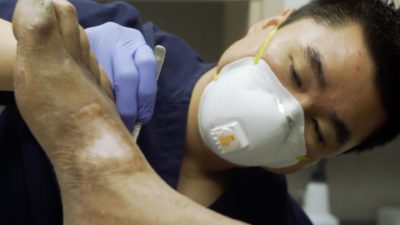How do you get rid of Plantar’s Wart?
If you suspect you have a plantar wart, you should check in with your doctor. It can be hard to tell how much the wart has grown beneath the skin. You should definitely see your doctor if the wart is causing you pain or spreading to another location.
In most cases, your doctor can diagnose a plantar wart with one or more of these techniques:
- Examining the lesion
- Paring the lesion with a scalpel and checking for signs of dark, pinpoint dots — tiny, clotted blood vessels
- Removing a small section of the lesion (shave biopsy) and sending it to a laboratory for analysis
- Treatment
Most plantar warts are harmless and go away without treatment, though it may take a year or two. If your warts are painful or spreading, you may want to try treating them with over-the-counter (nonprescription) medications or home remedies. You may need many repeated treatments before warts go away, and they may return later.
If your self-care approaches haven’t helped, talk with your doctor about these treatments:
Stronger peeling medicine (salicylic acid)
Prescription-strength wart medications with salicylic acid work by removing layers of a wart a little bit at a time. They may also stimulate your immune system’s ability to fight the wart. Your doctor will likely suggest you apply the medicine regularly at home, followed by occasional office visits.
Freezing medicine (cryotherapy)
Cryotherapy done at a doctor’s office involves applying liquid nitrogen to the wart, either with a spray or a cotton swab. This method can be painful, so your doctor may numb the area first.
The chemical causes a blister to form around your wart, and the dead tissue sloughs off within a week or so. Cryotherapy may also stimulate your immune system to fight viral warts. You may need to return to the doctor’s office for repeat treatments every two to four weeks until the wart disappears.
Some studies suggest that cryotherapy combined with salicylic acid treatment is more effective than just cryotherapy, but further study is needed.
Surgical or other procedures
If salicylic acid and freezing medicine don’t work, your doctor may recommend one or more of the following treatments:
- Other acids. Your doctor shaves the surface of the wart and applies trichloroacetic acid with a wooden toothpick. You’ll need to return to the doctor’s office for repeat treatments every week or so. Side effects include burning and stinging. Between visits, you may be asked to apply salicylic acid to the wart.
- Immune therapy. This method uses medications or solutions to stimulate your immune system to fight viral warts. Your doctor may inject your warts with a foreign substance (antigen) or apply a solution or cream to warts.
- Minor surgery. Your doctor cuts away the wart or destroys it by using an electric needle (electrodesiccation and curettage). This procedure can be painful, so your doctor will numb your skin first. Because surgery has a risk of scarring, this method usually isn’t used to treat plantar warts unless other treatments have failed.
- Laser treatment. Pulsed-dye laser treatment burns closed (cauterizes) tiny blood vessels. The infected tissue eventually dies, and the wart falls off. This method requires repeat treatments every three to four weeks. The evidence for the effectiveness of this method is limited, and it can cause pain and potentially scarring.
- Vaccine. The HPV vaccine has been used with success to treat warts even though this vaccine is not specifically targeted toward the wart virus that causes the majority of plantar warts.
Family Foot & Ankle Physicians has a primary location in Greenville, servicing cities such as Greenville, Farmville, Ahoskie, Kinston, Winterville, Tarboro, New Bern, Edenton, Washington, Rocky Mount, with patients coming from throughout eastern North Carolina and beyond. To request your appointment, call our Greenville office today, talk to your doctor about a referral or use the online booking tool to schedule your visit.
